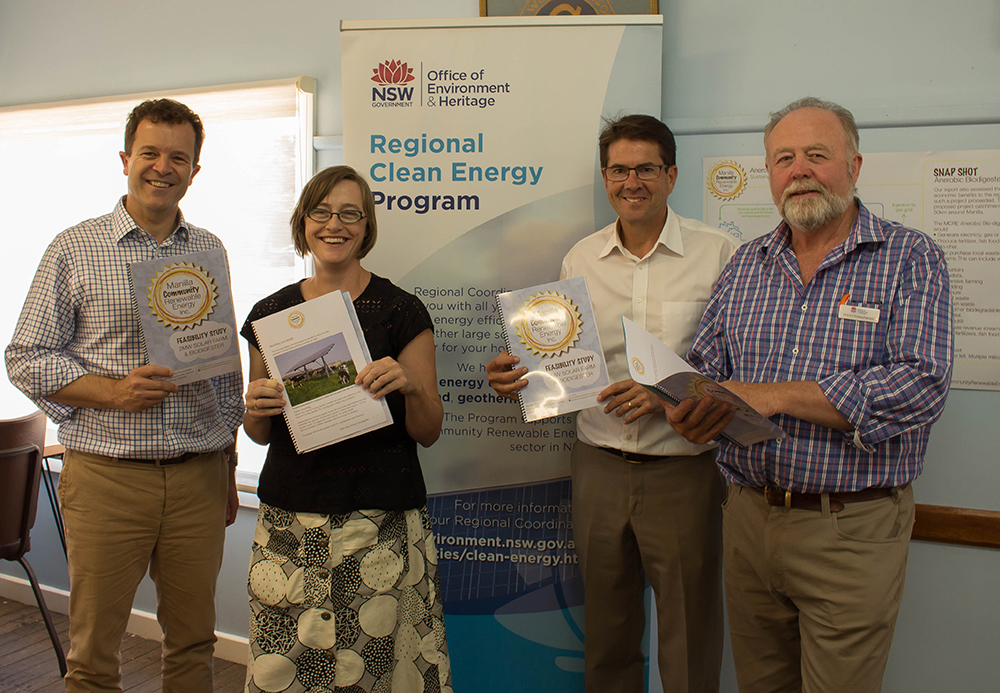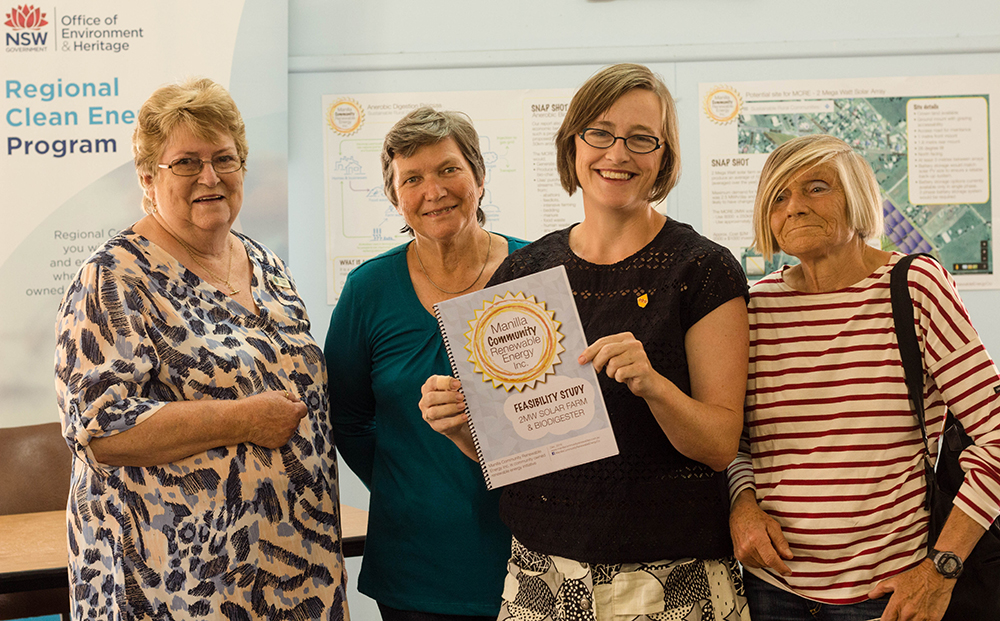
Hon. Mark Speakman (Minister for Office of Environment & Heritage), Emma Stilts (MCRE) , Hon. Kevin Anderson (Member for Tamworth) and Grant Christopherson (Office of Environment & Heritage)
A major feasibility study exploring renewable energy for the North West has earmarked Manilla and Tamworth as prime locations for multi-million dollar environmental investment.
The $46K dollar study found that Manilla has the ideal business model and climactic conditions to develop a community funded solar farm and a biodigester for Tamworth – with its large chicken, abattoir and other major industry is an ideal location to house an anaerobic digester – a large environmental plant that converts otherwise harmful industrial waste into valuable energy, animal foods and bio-char..
Our group was honored to have Hon. Mark Speakman. Minister for Office for Environment and Heritage and our local member for Tamworth Hon. Kevin Anderson in attendance to officially launch the study. As well as Councillors Helen Tickle and Jim Maxwell from Tamworth Regional Council.
The feasibility study, backed by Tamworth Regional Council, Deputy Prime Minister Barnaby Joyce, local MP Kevin Anderson and is the vision of Manilla Community Renewable Energy Company and Manilla Country Women’s Association and was funded by the NSW Government Office of Environment and Hertitage.
The study assessed a unique community owned solar farm for Manilla – a structure where the community is invited to invest in the project to raise the funds required to build it. When the farm is built, providing energy and making money, investors are rewarded financially and the community wins as well with cheaper power.
President of Manilla Renewable Community Energy Company, Emma Stilts says the success of the study paves the way solar partners and the community to become involved in the project.
“We now know this is a viable solar model where Manilla can benefit from cheaper power and investment. The funds made from this project will be significant and will come straight back to Manilla.
“Under this model local investors will pay for the purchase, installation, operation and maintenance of the solar farm. This means when the farm is operational, energy becomes a local business instead of an economic leakage.
“We’ll now start developing business partnerships with Manilla Renewable Community Energy Inc. and encourage community support and investment in the project,” said Ms Stilts.
Manilla Country Women’s Association President, Michelle Eggins says we have an opportunity to establish Manilla as model of sustainable regional development.
“Solar energy is tried, tested and dependable. With this clever planning we are looking beyond our lifetime and setting the stage for Manilla to be financially sound well into the future”, she said.
In Tamworth, Manilla Community Renewable Company will now source business partners establish one of the first anaerobic bio-digesters in regional NSW.
Using industrial waste, the plant, will have the ability to generate electricity, gas or heat, produce fertiliser, fish food or bio-char.
Ms Stilts said ‘The study shows that Tamworth’s major industrial sector produces more than enough waste from abattoirs, feedlots, intensive farming, human waste and other biodegradable products to establish an anaerobic bio-digester.
‘This project will require major investment and support from industry but would have far-reaching financial gains and massive environmental benefits,’ she said.
Both levels of government welcomed and encouraged the project saying there is a clear opportunity for agricultural waste to be put to better use.
In relation to local biohub opportunities – Agricultural residues such as straws, manures, effluents currently present us with waste disposal costs or undervalued residues. The possible bio-chars and energy products that are possible through this project represent a market value of some $200-$300 per tonne – wheat itself is only fetching some $250 per tonne.
There is lasting and proven value in generating strong income from agricultural and forestry residues. If this were adopted across the whole Australian agriculture and forestry sector it could double gross agricultural output from the same acreage.
Work will start immediately in sourcing continued and new business partnerships and community support for these projects. Interested parties can contact Manilla Community Renewable Inc.

MCRE Crew – Michelle Eggins, Margaret Hurle, Emma Stilts and Robin Gunning

